Home »

Heroic family hid Jewish couple from Nazis
By Elinor Florence
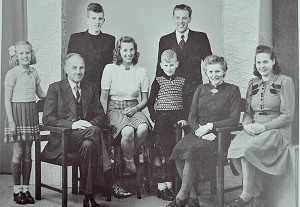 This is the 70th anniversary of the liberation of Holland by the Canadian Armed Forces, so it’s an appropriate time to remember the courage shown by one Dutch family.
This is the 70th anniversary of the liberation of Holland by the Canadian Armed Forces, so it’s an appropriate time to remember the courage shown by one Dutch family.
We’ve all heard the story of Anne Frank, but this family’s experience was no less remarkable.
Casey Scheffer and his wife Toni ran the bakery in Kimberley for many years, before retiring to Invermere.
Casey died last year at the age of 93, but before he passed away he told me this remarkable story of how his family in Holland saved the lives of a Jewish couple during the Second World War by hiding them for two long years.
Casey was 19-years-old when the Germans occupied Holland in 1940. He was the eldest son of six children – three boys and three girls. (In the family photo, Casey is standing on the right.)
The Scheffers lived in the town of Nijverdal, where his parents operated the local bakery out of their spacious brick home. Along with the eight members of the immediate family, three unmarried aunts also lived in the house.
 It was a peaceful little town, about 50 kilometres from the German border.
It was a peaceful little town, about 50 kilometres from the German border.
Here’s an aerial photograph of the countryside around Nijverdal today.
DEPORTATION OF JEWS BEGINS
Imagine the horror experienced by the Dutch people when the Nazis marched into Holland, into every city and village including Nijverdal, and took control of their everyday life.
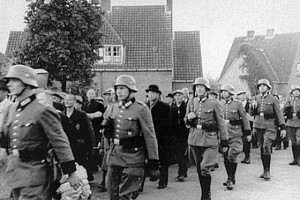 Here’s a chilling photo of Nazi soldiers occupying a Dutch town.
Here’s a chilling photo of Nazi soldiers occupying a Dutch town.
“At first the Germans didn’t bother us too much, and life went on as before,”
Casey told me. “But in 1942 they started rounding up Jewish people around the country and sending them away on the train. We knew about it, because we listened to the BBC on our secret radio.”
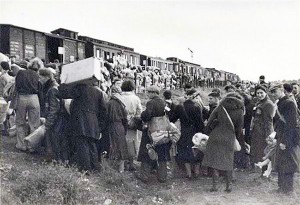 It was a terrible situation that was being repeated all over Europe. Here’s a photo of Jews boarding a train, carrying all their worldly possessions, without an inkling of the fate that was in store for them.
It was a terrible situation that was being repeated all over Europe. Here’s a photo of Jews boarding a train, carrying all their worldly possessions, without an inkling of the fate that was in store for them.
Then one day in the spring of 1943, the dreaded order came: all Jews in Nijverdal had to be ready to leave the following Saturday morning.
SAMUELS GO INTO HIDING
Only 11 Jewish families lived in Nijverdal. One couple, David and Betje Samuel, owned a clothing store and had two little girls. The minister of the church attended by the Scheffers begged them for help.
Although the Scheffers knew what this would mean if they were caught – death for themselves and their children – they didn’t hesitate.
They were supposed to keep the Jewish couple for only a few days – until the coast was clear again. However, Mrs. Samuel collapsed and could not face another move, and so the Scheffers let them stay.
What motivated Cornelus and Hendrikje Scheffer to risk their children’s lives?
Casey said his parents, who were members of the Dutch Reformed Church, had a strong Christian belief in helping the persecuted Jewish people.
“My mother said the Jews are the chosen people of God, and if they are blessed and kept safe, then so God will keep us safe also.”
Two other Dutch families each took one of the little Samuel girls, while the Scheffers agreed to hide the parents.
 The other 10 Jewish families in Nijverdal were loaded onto the train and never seen again.
The other 10 Jewish families in Nijverdal were loaded onto the train and never seen again.
This is an old photograph of the train station in Nijverdal where the Jews left their home for the last time.
The Samuel couple was smuggled to the Scheffer house, a long, low, 16-room house made of brick with a tile roof, similar to all the other houses on the pleasant, tree-lined street. The bakery was attached to the house.
The Samuels were given two rooms at the front of the house. Their windows overlooked the street, but these were concealed by two large oak trees. The huge overhanging branches prevented anyone from seeing inside, similar to this photo of a house in this Dutch village.
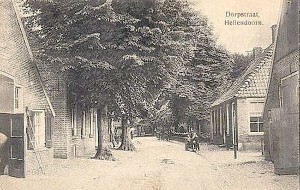 David and Betje Samuel stayed in their two rooms for two entire years, until the war ended. Casey explained: “My mother told everybody that she had too much housework, so she locked those rooms, and everyone believed they were empty.”
David and Betje Samuel stayed in their two rooms for two entire years, until the war ended. Casey explained: “My mother told everybody that she had too much housework, so she locked those rooms, and everyone believed they were empty.”
Friends, neighbours and even the three youngest Scheffer children did not know there were Jews hiding in the house.
“My parents were too worried the youngest children might say something. If the Jews had been found, that would have been the end of all of us, the children, everybody.”
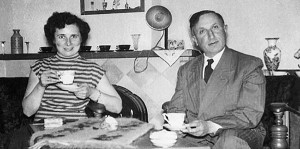 The young couple never left their rooms, except to sneak into the Scheffer living room for a visit at night when the youngest children were asleep in bed.
The young couple never left their rooms, except to sneak into the Scheffer living room for a visit at night when the youngest children were asleep in bed.
Here is a photograph of the young couple in the Scheffer living room. The reason Betje is smiling is that this photograph was taken just after the war ended.
NAZIS SEARCH THE SCHEFFER HOME
There were a few close calls, Casey said. “Twice the Germans came and searched the house, but my father always laughed and spoke in a loud voice so the couple would hear and go into their hiding place.”
Mr. Scheffer would first take the Germans into the loft to search, giving the couple enough time to conceal themselves behind a secret panel in the wall, covered with the same wallpaper as the rest of the room.
The couple did not see or communicate with their two daughters during the entire time they lived with the Scheffers.
“They didn’t even know where their daughters were. We told them the girls were safe, but it was better if they didn’t know their location.” That way, if either the parents or the girls were captured, they could not be forced to reveal where the others were hiding.
CASEY WAS IN HIDING, TOO
The Scheffers didn’t only save Jewish lives. In fact, their house was a haven for refugees during the war, including Casey himself.
In 1942 the Germans began to recruit young Dutch men into their armed forces. Although some of Casey’s friends were forced into service, he spent the rest of the war hiding in his own house!
Casey had a special trap door under his bed that led to a closet, where he hid when the Germans showed up. Because his parents never registered Casey to receive food ration coupons, the Germans were unaware of his existence. During the darkest hours of night, Casey continued to help his father in the bakery. And he also joined the Dutch Resistance.
“My parents knew I belonged to the Resistance, but I never told them all the things I got up to,” Casey laughed. A twinkle came into his eye as he recalled how he and his friends used to set fires and even managed to blow up a tunnel used by the Germans.
“Really, we had fun,” he said. “We were young, we were never scared, we just despised the Germans and wanted to stop them as much as we could.”
He said he recklessly used to give German soldiers the Victory sign when he passed them on the street – holding up two fingers in a V that was the universal symbol used by the Allies to mean Victory in Europe.
SCHEFFERS HIDE AMERICAN AIRMAN
At that time the air war was raging overhead, and many aircraft were being shot down over Holland. If the airmen survived, they were sometimes lucky enough to be picked up by members of the Dutch resistance.
“When I went bicycling in the countryside, delivering bread in my basket, I always wore two sets of clothing. That was if I came across an airman whose plane had been shot down, I would take off his uniform and bury it along with the parachute, then give him the extra set of clothes and take him to my house.”
These airmen passed quickly through the Scheffer household on their way back to England, smuggled from house to house and then onto a boat that would ferry them across the English Channel after dark.
But Casey recalls that one of them, a young American named John Zolner, spent a long time living with the Scheffers and even helped out in the bakery at night, before he could finally be smuggled away.
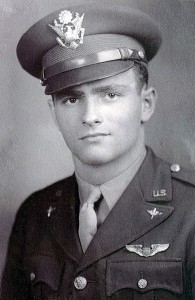 Here’s a photo of John Zolner, who survived the war and returned to his home in New York state.
Here’s a photo of John Zolner, who survived the war and returned to his home in New York state.
It seems incredible that so many people could have hidden in the house, yet
Casey believes they got away with it because the house also functioned as a bakery, with people coming and going all day.
THE SAMUELS TRIED TO HELP
The Scheffers tried to find tasks for David and Betje Samuel, who must have been terribly restless, but that almost got them into trouble.
“It was David’s job to stick all the food coupons that people had turned into the bakery into a coupon book, but he did it so carefully that someone got suspicious and asked: ‘How do you have time to make your coupon book look so neat?’ After that, he had to do it less carefully.”
And it was Betje’s job to unravel old sweaters and knit them into new sweaters for the children. One day a neighbour asked Mrs. Scheffer how she found the time to knit all those sweaters! She quickly replied that the three maiden aunts in the house did all the knitting.
LIBERATION AT LAST
During the final year of the war, food supplies dwindled and people were starving. Fortunately the Scheffers were able to feed themselves and their guests, thanks to the bakery. Their property was large enough for a huge vegetable garden, and they killed scores of rabbits in the surrounding countryside.
Casey remembers the day that war finally ended. “People were singing and dancing in the streets, and the Canadians were rolling into town in their trucks.”
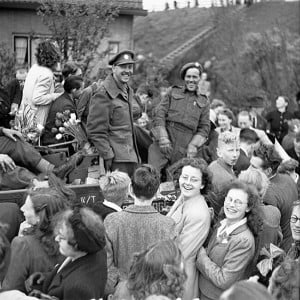
It was the Canadian Armed Forces that liberated Holland after fierce fighting, earning them a special place in Dutch hearts to this day.
You can see the joy on the faces of both the Dutch civilians, and the infantrymen of the West Nova Scotia Regiment, in this photograph taken on May 9, 1945.
SAMUELS REUNITED WITH DAUGHTERS
Casey said it was another three or four days before David and Betje could be coaxed from their hiding place. They had lived in fear for such a long time that they wanted to be absolutely sure the Germans weren’t coming back. When they finally emerged, they were reunited with their little girls, whom they hadn’t seen for years.
And the people of Nijverdal helped them make a fresh start. The family returned to their old home, and using money they had hidden, they were able to start their clothing business again.
The four members of the Samuel family were the only Jews from Nijverdal who survived. The other 10 families all died in Nazi concentration camps.
SCHEFFERS MOVE TO CANADA
But the connection between the Scheffer and the Samuels didn’t end there.
In 1951, Casey announced his intention to emigrate to Canada. His father was so distraught at the idea of the family being separated that he decided that everyone should go with Casey.
As Casey recalled: “My father said: ‘I can’t miss you so much!”
The two parents and all six children, now adults, spent the first year working on a sugar beet farm near Lethbridge, Alberta.
The following year, David Samuel flew to Canada to visit them.
“He heard it was really cold in Canada, and he just wanted to make sure we were all right!”
He also sent money to the Scheffers from the sale of their bakery in Holland, money that they weren’t legally allowed to take out of Holland when they left.
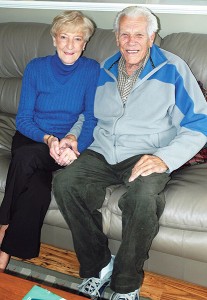
The following year Casey moved to Kimberley, British Columbia and worked in a bakery. There he married another Dutch immigrant, a beautiful girl named Toni.
The young couple purchased the bakery and operated it for 25 years while raising four children: Arnold, twins Pieter and Andy, and daughter Jami.
After retirement, the Scheffers moved to Invermere, where Toni still resides.
SCHEFFERS RECEIVE HIGHEST HONOUR FROM ISRAEL
Imagine Casey’s surprise in 2007 when he received a letter from Jerusalem, from an organization called the Commission for the Designation of the Righteous.
Casey’s parents, Cornelus and Hendrikje Scheffer, were being awarded posthumously the title “Righteous Among the Nations” for help rendered to the Jewish people during the Holocaust at the risk of their own lives.
This is the highest honour that Israel can bestow on non-Jews who risked their lives to save Jews during the Holocaust.
It is the same award bestowed on Oskar Schindler, made famous by the movie Schindler’s List!
After the war the Samuels had two more daughters, for a total of four girls, all of whom had children of their own. There are now almost 50 family members. (David died in 1975, at the age of 72. Betje lived to be an old lady of 95, and died in Nijverdal in 2005.)
The award came about through the efforts of Ruth Samuel Tenenholtz, the third daughter, who was born in 1946 and now lives in Israel. She indirectly owes her life to the Scheffers.
Ruth flew to Calgary, Alberta in November 2007 where a ceremony was held at the Jewish Community Centre to honour the Scheffer family.
Casey and Toni attended, along with their children and grandchildren; Casey’s younger sister Henny of Nanton, Alberta; and his younger brother Tony of Edmonton.
In the letter that Ruth sent to Casey, she wrote: “I hope you will come with your family – children and grandchildren, neighbours and friends – because truly this is a day we shall shout from the rooftops! I hope to see you and yours there, so we can look into each other’s eyes and say: “See – we are striking a blow today for the good folks in the universe!”
Pictured above (lead image) with Casey and Toni Scheffer is Ruth Samuel Tenenholz, who would not be alive today were it not for Casey’s parents.
Said Ruth: “I felt I had completed something for my father, who called the Scheffers ‘Papa and Mama,’ and loved them all the days of his life.”
ABOUT ELINOR FLORENCE
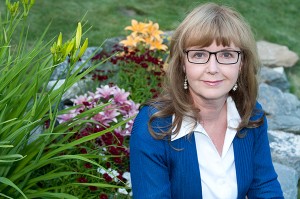 Career journalist Elinor Florence, who now lives in Invermere, has written for daily newspapers and magazines including Reader’s Digest. She writes a regular blog called Wartime Wednesdays, in which she tells true stories of Canadians during World War Two. Married with three grown daughters, her passions are village life, Canadian history, antiques, and old houses. You may read more about Elinor on her website at www.elinorflorence.com.
Career journalist Elinor Florence, who now lives in Invermere, has written for daily newspapers and magazines including Reader’s Digest. She writes a regular blog called Wartime Wednesdays, in which she tells true stories of Canadians during World War Two. Married with three grown daughters, her passions are village life, Canadian history, antiques, and old houses. You may read more about Elinor on her website at www.elinorflorence.com.
 Elinor’s first historical novel was recently published by Dundurn Press in Toronto. Bird’s Eye View is the only novel ever written in which the protagonist is a Canadian woman in uniform during World War Two. The heroine Rose Jolliffe is an idealistic Saskatchewan farm girl who joins the Royal Canadian Air Force and becomes an interpreter of aerial photographs. She spies on the enemy from the sky and makes several crucial discoveries. Lonely and homesick, she maintains contact with Canada through letters from the home front. The book is available through any bookstore including Lotus Books in Cranbrook, and also as an ebook from any digital book provider including Amazon, Kindle and Kobo. You can read more about the book by visiting Elinor’s website at www.elinorflorence.com/birdseyeview
Elinor’s first historical novel was recently published by Dundurn Press in Toronto. Bird’s Eye View is the only novel ever written in which the protagonist is a Canadian woman in uniform during World War Two. The heroine Rose Jolliffe is an idealistic Saskatchewan farm girl who joins the Royal Canadian Air Force and becomes an interpreter of aerial photographs. She spies on the enemy from the sky and makes several crucial discoveries. Lonely and homesick, she maintains contact with Canada through letters from the home front. The book is available through any bookstore including Lotus Books in Cranbrook, and also as an ebook from any digital book provider including Amazon, Kindle and Kobo. You can read more about the book by visiting Elinor’s website at www.elinorflorence.com/birdseyeview







